Technical features of cars
Before deciding whether to choose a Tiguan or a Rav 4, you can conduct a comparative analysis of these two cars.
Volkswagen Tiguan
The first crossover produced by this brand. First presented to the public in 2007. Today it is assembled in Russia, which allows Russian buyers to purchase components at fairly low prices.
Dimensions of the car: its length is 448.6 cm, its width is 183.9 cm, and its height is 167.3 cm.
Toyota RAV4
The car appeared on the market long before its opponent, in 1994, but every year it gets better. Initially it was positioned as a transport for active youth, which it remains to this day.
Dimensions of the car: its length is 460 cm, its width is 185.5 cm, and its height is 169 cm.
2021 RAV4 vs Tiguan comparison
The RAV4 and Tiguan models are constantly being improved. To understand which car to choose, you need to study the review. A comparison of RAV4 and Tiguan is presented in table form.
| Characteristics | Toyota RAV4 | Volkswagen Tiguan |
| Transmission type | Manual transmission 6 | Manual transmission 6 / Manual transmission 6 |
| Power, l. With. | 146-180 | 125-220 |
| Fuel tank volume, l | 55 | 60 |
| Body length/width/height, mm | 4605/1845/1685 | 4486/1839/1632 |
| type of drive | Front (FF) | Full (4WD) |
| Transmission type | Automatic 8 | Manual transmission 7 |
| Power | 149-199 | 125-220 |
| Fuel tank volume, l | 55 | 60 |
| Body length/width/height, mm | 4600/1855/1685 | 4486/1839/1673 |
| type of drive | Front (FF) / Full (4WD) | Front (FF) / Full (4WD) |
On a note!
Volkswagen Tiguan is available in 7 trim levels: “Trendline”, “All Inclusive”, “OffRoad”, “Connect”, “Connect Plus”, “Highline” and “Sportline”. Toyota Rav 4 has 6 options: “Standard”, “Standard Plus”, “Comfort Plus”, “25th Anniversary”, “Prestige” and “Prestige Safety”.
Exterior
The second generation looks much more advantageous than the first, which received many unflattering comments. After restyling in 2016, the model significantly changed its exterior. The lines have become smoother, the width and length have increased compared to its predecessor, and the height has become smaller. The body has two options - off-road and urban. Tiguan has become good over the years, even according to experts, which is why it was recognized as the best in its category in 2021.
If you compare with it the Toyota Rav four, the fifth generation of which was released in 2021, then they are similar in many ways, because the Japanese crossover, competing against the German, also looks stylish and resembles all the classic models of this brand.
Summary
The 2021 Volkswagen Tiguan looks very attractive in every way. It costs less than its competitor in basic configurations, the costs of its maintenance and voluntary CASCO insurance are lower, and in dynamics and efficiency the “German” is superior to its opponent. However, Toyota Rav4 2021 is a newer model with a 25-year history that is admired all over the world. Raf 4 will definitely appeal to fans of top versions of cars and those who don’t like turbocharged engines and robotic gearboxes. Many people put off buying a new crossover because they were waiting for the fifth generation RAV 4 to appear. Therefore, there will be increased interest in this new product in the first half of this year. But it is unlikely that the demand will be so high that it will allow the “Japanese” to regain lost positions in the Russian market, because it has no weighty arguments in its favor. This is confirmed by statistics on sales of new cars for the first five months of 2021, in which 13,060 units were purchased. — Volkswagen Tiguan and 10,657 units. — Toyota RAV4.
Salon and trunk
You can compare Tiguan and Rav 4 in terms of internal contents.
The seats of the new Tiguan have a combined finish, its steering wheel is trimmed in leather, and all the available electronics can be easily configured the way the owner wants it. The optics are LED, the preheater has a timer, and the rear view camera has a washer.
Despite the difference in size, you won't have to tuck your knees to your chest in the rear seats - there is more than enough legroom. In addition, pull-out tables, 12-volt USB sockets and private climate control are available in the rear. However, there are no heated seats.
The Tiguan's trunk is quite large; when the rear seats are folded, which can be done either from the interior or by pressing a button in the trunk, its volume will be more than 600 liters. But in this situation it will be impossible to carry adult passengers in the back. There is a 220-volt outlet in the trunk of a Volkswagen, which is an undeniable advantage.
Read also Which is better: Kia Sportage or Volkswagen Tiguan
Toyota, in turn, has more pleasant-to-touch seats because they are trimmed with leather. Navigation is voice controlled, the interior has a lighting system, and the driver's seat is electronically adjustable. Also, when choosing a car, you should pay attention to the fact that the new Rav4 has a wireless charger available. An additional compartment for storing glasses will also be a bonus. Cruise control is adaptive, with the ability to recognize road signs.
A passenger whose height is more than 180 centimeters will feel comfortable even in the back seat, since the “reserve” for taller passengers is 15 centimeters. The rear sofa can be heated, the angle of the backrest can be selected individually. In the back of the Rav there are two outlets, but only one lamp.
This crossover will be much more comfortable for five people to ride in - it is wider than a Volkswagen.
The Toyota trunk, although its stated dimensions are smaller, has greater depth and width, which makes it more functional when compared to the Tiguan. Folding the rear seats to use the trunk in full is only possible mechanically; the Japanese car does not offer any automatic equipment here.
Results and conclusions
Tiguan can be recommended for more or less civilized places where high-quality fuel, oils, spare parts and service are available. Then it will delight the owner with its dynamics and efficiency, modern and at the same time classic appearance, ergonomic and comfortable interior.
The RAV4, with its omnivorous, relatively simple atmospheric engine and slightly better off-road capabilities, is more suitable for the outback, where the very fact of movement is more important than comfort, and there is still nowhere to realize dynamic performance.
Read further:
Comparison of prices and trim levels of Tiguan
What is the best engine in the Volkswagen Tiguan?
Volkswagen Taos engine: description and comparison
Which engine to buy Teramont with: question of taxes, consumption, comparison
Formulas of meaning: which is better Polo Liftback or Kia Rio
Review from the owner of Volkswagen Jetta 1.6 automatic
Engines and transmissions
The engine of the German car has two options: 1.4 and 2.0 liters, which can be combined with a six- or seven-speed robot. You can choose between a diesel or gasoline engine with all-wheel drive, either automatic or manual transmission.
The new Toyota Rav4 offers the buyer a choice between petrol and diesel engines with a volume of 2 and 2.5 liters. The smaller one can be equipped with a manual transmission or a CVT, while the larger one works exclusively with an automatic transmission.
If you need a powerful car, then the battle “Tiguan or Rav4” definitely wins the second one. If fuel consumption is important, then you should choose the first one.
What to choose - expert opinion
When choosing a Tiguan or Rav4 2021, you need to rely on the opinion of an expert. Analysts believe that the Japanese car is truly reliable, as evidenced by the number and cost of RAV4 on the secondary market.
But experts advise focusing on your own preferences. Volkswagen Tiguan owners receive a greater number of assistants in the minimum configuration, which is 100,000 cheaper than its Japanese counterpart.
Fuel consumption indicators also speak in favor of the German car. They are 1-1.5 liters less than the Toyota RAV4. But the Japanese representative has more powerful and dynamic engines.
Speaking of off-road, you need to understand that these crossovers are not prepared for serious tests. Even in the city, not all holes and bumps are worth “storming” without danger.
Therefore, the car enthusiast must decide for himself: Rav 4 or Tiguan, here the opinion of a specialist does not play a final role, because crossovers have their own strengths and weaknesses.
Dynamics, fuel consumption
Let's compare the dynamics.
Volkswagen, having an engine capacity of 1.4 liters, accelerates to hundreds in 9.2 seconds, its maximum speed is 200 km/h, with a consumption of 6.8 liters of fuel per hundred.
A diesel with 150 horses will accelerate a second longer, having the same maximum speed while consuming 0.7 liters less. 180 horsepower will allow you to reach hundreds much faster, in 7.7 seconds, with a maximum of 208 km/h, and fuel consumption of 8 liters.
A crossover boosted to 220 hp will require even more fuel - almost 8.5, but will accelerate to a maximum of 220, reaching the first hundred in the shortest time - 6.5 seconds.
For comparison, a two-liter all-wheel drive Rav4 with 149 horsepower can accelerate to 100 km/h in 11 seconds, a front-wheel drive one with the same number of horses will behave better and do it a little faster - in 9.8 seconds. Fuel consumption, depending on the model, will range from 6.5 to 11.3 liters.
Read also Volkswagen Polo or Volkswagen Jetta: which is better and more reliable
Maintenance costs
When considering any of these cars for an upcoming purchase, you need to understand that we are talking about quite expensive crossovers that have service costs commensurate with them. It’s impossible to name a clear favorite here that would cost significantly less, since in general these models are approximately equal. You just have to take into account that some parts and consumables will be more expensive for a German new product, while others, on the contrary, will be more expensive for a Japanese crossover. For this reason, it will not be possible to determine which is better to choose based on the upcoming future costs of maintaining a vehicle. Another point that will clearly make it possible to determine which cross in this case is the more economical option to purchase is the fuel costs that motorists have to deal with on a daily basis. In this case, the Toyota RAV4 consumes less gasoline in the combined cycle, although this difference is not so noticeable and will only appear over a distance. However, this Japanese crossover can be fueled with more affordable AI-92 fuel, which is an order of magnitude cheaper than AI-95, suitable for Tiguan. Here it is also worth taking into account the fact that not all car owners are able to maintain factory fuel consumption parameters.
Handling and maneuverability
Japan vs Germany.
For Toyota, light off-road conditions are not an obstacle, unevenness does not affect comfort, but large potholes and pits should be avoided, since, according to experts, the car’s suspension is quite stiff, which is why driving over significant unevenness causes extraneous noise in the cabin.
The Tiguan can be configured for off-road driving by choosing between the following: Standard, Comfort and Sport, which will allow the car to become more stable.
It is worth saying that only off-road conditions play against these cars. If we compare them in more standard conditions, both the Volkswagen Tiguan and Toyota perform well on paved roads, maintaining excellent handling even at high speeds.
Tiguan or RAV 4: car appearance
To compare the Volkswagen Tiguan and Toyota Rav 4, you need to evaluate the appearance, interior, options, engines and get acquainted with the reviews of car enthusiasts. Let's start with the exterior of the cars.
The comparison will include versions of RAV4 (CA40 restyling) and Tiguan II.
The designers of the Japanese brand made the car in the classic Toyota style - a solid exterior with large arches and a stylish front end. Judging by its appearance, the vehicle was being prepared for off-road use.
The representative of the German automobile industry is also interesting in terms of appearance.
The second version of the crossover has become wider, longer and slightly lower.
Many people said about the previous modification of the car that it “looked like a duck.”
Volkswagen designers, like their colleagues from Toyota, have retained the main body differences of the vehicle. The off-road version is especially attractive for motorists, with a ground clearance of 200 mm.
In Tiguan, analysts also note the successful design of the front optics; built-in LEDs make the car more modern. But the practical benefits of this design decision are noticeable only in the maximum trim level, where the headlights shine really well.
Security systems, options
Which is safer: Rav4 or Tiguan? The opinion of the experts of the European Committee is that both cars have the maximum safety rating, so you can choose one or the other based on this criterion.
The minimum VW package includes cruise control, a multimedia system, steering wheel adjustment on both axes, a driver fatigue sensor, heated front seats, a collision avoidance system, a fabric interior, six airbags, and climate control.
The minimum configuration of the Toyota crossover has the following set of equipment: multimedia system, cruise control, steering wheel adjustment on both axes, rear camera, single-zone climate control, light, rain, tire pressure sensors, fabric interior, heated windshield, windshield washer nozzles, mirrors, steering wheel and front seats.
East and West
The appearance that the RAV4 received in 2021 with the change of generations turned out to be unusually daring. The characteristic box-shaped shape, high hood line and large glass area set a parallel with the “older” frame SUV Land Cruiser Prado. On the other hand, sharp body chamfers refer to the premium “brothers” of Lexus with their presentable origami-style design. In a word, brutality and glamor merged into one.
Tiguan looks more restrained, I would say, more intelligent. It seems that it is only masquerading as a crossover, but wash it with shampoo and the “donor”, the Golf hatchback, will appear on the scene. The ground clearance by SUV standards for both rivals is not a record – 195 mm for the “Japanese” and 191 for the “German”. But the RAV4 is identified as a rugged SUV, and the Tiguan as a tall off-road hatchback (even the silver edging of the bumper emphasizes the emphasis on urban use).
I also see two different worlds in salons. I sit behind the wheel of the Rafik, as if I were climbing onto the judge’s tower near the tennis court. The multi-layer, sandwich-like front panel and upper sectors of the door cards are trimmed with eco-leather and stitched with thread - it looks expensive. The front seats are completely devoid of a sporty profile. You sit as if in a home chair, and place your right elbow on the wide box-armrest. It’s just a pity that the feeling of status is destroyed in the bud by the unfashionable analogue instrument panel and the central 8-inch display with simple graphics and keys in the style of radio tape recorders, popular even before the millennium.
The interior of the German opponent is democratic and laconic to the point of boredom. Apart from the steering wheel trim, there is no leather covering. However, the feeling of prestige is stronger than in the RAV4, and all because of the expensive options - a huge panoramic roof with a sliding sunroof and a 9.2-inch Discover Pro multimedia touchscreen, which the model acquired after a recent restyling. The tidy, by the way, is also digital; navigation can also be displayed on it. However, in my opinion, Volkswagen even went a little overboard with digitalization. Detailed pictures of the all-round viewing system, no words, a useful thing. But the audio system was deprived of a physical volume control knob (for this, the passenger will need to delve into the depths of the monitor settings), the touch sliders for controlling the three-zone “climate” need to get used to, and the USB slots of the Type-C format almost played a cruel joke on me: during the test it started The phone was connected, but I couldn’t connect via the traditional Type-A cord, which I always have with me - there’s no such connector here in principle.
SOFA MOOD The doors of both test participants completely cover the thresholds; clothes will not get dirty during disembarkation and embarkation.
The packages of “warm” options in both cases are also extensive - there is heating of external mirrors, steering wheel, front seats, rear and windshields, plus washer nozzles for the latter, but the “climate” in the Tiguan is three-zone versus the two-zone in the RAV4.
Repair and service
Maintenance must be done every thousand kilometers; servicing a car is quite expensive.
At official VW dealers, according to data for 2021, the price for it was 8.5 thousand rubles. For comparison, for Rav4 it will cost at least 7.8 thousand.
The cost of compulsory motor liability insurance for Tiguan varies within ten thousand rubles, and CASCO will cost about fifty thousand rubles.
The cost of CASCO for Toyota will be about thirty thousand rubles, OSAGO - five thousand.
Cost of ownership
When buying a new car, few people think about the cost of maintenance. But knowing it in advance, perhaps the choice would have been made differently. Therefore, let's compare the costs of routine maintenance at official dealers up to 60,000 km (inclusive). Volkswagen Tiguan 2021: TO-1 (15,000 km) - 10,780 rubles, TO-2 (30,000 km) - 20,175 rubles, TO-3 (45,000 km) - 10,780 rubles. and TO-4 (60,000 km) - 20,175 rubles. Total: 61,910 rubles. Toyota Rav4 2019: TO-1 (10,000 km) - 13,786 rubles, TO-2 (20,000 km) - 22,610 rubles, TO-3 (30,000 km) - 13,786 rubles, TO-4 ( 40,000 km) - 21,230 rubles, TO-5 (50,000 km) - 13,786 rubles. and TO-6 (60,000 km) - 22,610 rubles. Total: 107,808 rubles, that is, 45,898 rubles. (74%) more expensive. Converted per 1 km of mileage, the repair costs are as follows: Tiguan - 1 ruble 3 kopecks, Rav 4 - 1 ruble 80 kopecks.
And in conclusion, let's compare the cost of CASCO. To do this, we will use online calculators. And as initial data, let’s take a car for 2,000,000 rubles, which in Moscow will be driven by a 45-year-old divorced man with two children who has 20 years of driving experience. Depending on the company and type of policy, insurance for VW Tiguan 2021 vs Toyota RAV4 2021 costs: Rosgosstrakh “Anti-crisis CASCO” - 22,082 rubles. vs RUR 28,536 and OSK "Economy" - 50,331 rubles. vs RUR 58,254 It turns out that you will pay more for the risk of theft and damage to a Japanese crossover.











